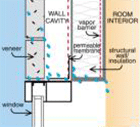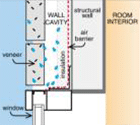The Rainscreen Advantage
Healthy Wall Solutions
The Enemy Within the Wall
Conditions within a building typically vary from those outside. These temperature and pressure differentials can have potentially damaging results, such as water vapor drive and condensation, as nature tries to equalize the imbalances.
Water Vapor Drive:
When humidity differs from the inside to the outside of a building, water vapor from areas of higher concentration tries to migrate to areas of lower concentration. When the pressure within the wall cavity is lower than the external pressure, water vapor is actually drawn in through permeable wall materials and voids, which occur wherever the vapor barrier is interrupted by windows, outlets and other interfaces.
Condensation:
In any climate, conditions occur which cause condensation within the wall assembly. Since the temperature within the building differs from that outside, gradients occur across the wall between the two zones. The greatest temperature drop occurs in the components with the best insulating properties. If enough water vapor is present, this shift in temperature causes the air to reach its saturation point, creating condensation within your wall cavity, often within the insulation.
What happens to this wall cavity moisture?
In traditional construction, this moisture becomes trapped and begins to deteriorate masonry veneers, corrode metal components of the structural wall, cause mold and mildew formation, or to find its way through to your interior, damaging interior finishes. Moisture can also damage your insulation, greatly reducing its R-value and increasing energy costs.
RAINSCREEN—THE PROACTIVE SOLUTION
Rainscreen recognizes the fact that moisture is a natural occurrence within the wall cavity. An uninterrupted, impermeable air barrier is created on the outside of the structural wall, integrated with the window panels, allowing no gaps for air and moisture flow to the interior. Veneer joints are left open to allow air circulation within the wall cavity, keeping the insulation dry by allowing moisture to evaporate.
Rainscreen Wall Details
Traditional Construction

Vapor barrier is interrupted at floor and window lines, outlets, etc. Adequate wall cavity air flow and drainage is not provided. Wall interior is inaccessible.
Rainscreen Construction

Air barrier is continuous and integrated with window systems. Air flow allows for evaporation of moisture. Separate panels allow easy access if needed.
W.J. Higgins & Associates provides innovative solutions to improve wall health and longevity. We use a refined rainscreen technology that combines the latest technological developments with the same principles that have helped European architects create elegant and enduring structures through the centuries. The result is a weather-resistant barrier that can stand up to even the harshest climates in the United States.
“Open–joint, back-ventilated, pressure-equalized” rainscreen technology allows adequate air circulation so wall cavities remain dry, insulated and corrosion free‑an approach that has provided a 100% success rate.
With the exterior veneer no longer filling the role of air barrier, new horizons for design are possible, with results everyone can appreciate:
ARCHITECTS enjoy the aesthetic benefits of greater design flexibility. Window and wall veneers require no caulking, resulting in cleaner design lines. By eliminating the need for sealants, panels never develop unsightly leaching around edges as caulking weathers.
BUILDING OWNERS appreciate having low-maintenance facades that require less cleaning and have no sealants to replace—a substantial maintenance cost associated with a traditional construction process. The use of rainscreen also eliminates corrosion within the wall and optimizes the effect of the insulation, enhancing its R-value and reducing the dependence on heating and cooling systems.
CONTRACTORS find that rainscreen gives them scheduling freedom not available with traditional methods, since construction can proceed on interior walls before the engineered veneer is in place.

